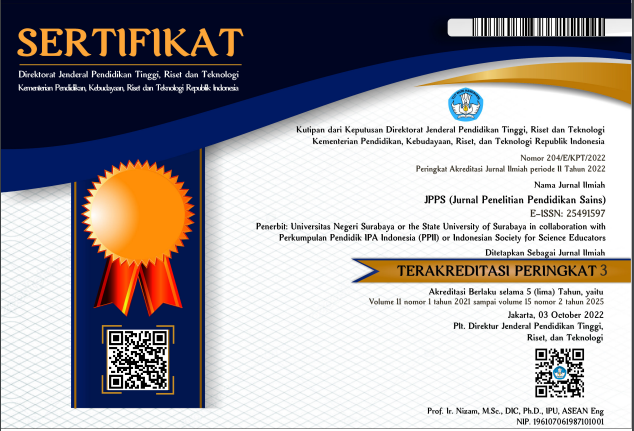Development of Virtual Simulation to Reduce the Number of High School Students' Misconceptions about Fluid Topics
DOI:
https://doi.org/10.26740/jpps.v12n1.p100-107Keywords:
Fluid , Misconception, Technology, Virtual SimulationAbstract
Teachers in learning activities should carry out practicum activities to facilitate students' learning, so there are no misconceptions. The facts in the field say that many teachers still do not do practicum because of the availability of tools and materials at the school, so virtual simulations are needed as a medium in practicum activities. The development model used in this study consists of three stages, namely the definition stage, the design stage, and the development stage. The results showed that the virtual simulation was feasible to use in the learning process. The validation analysis on the developed virtual simulation with very achievable criteria. In the student's opinion, the virtual simulation feasibility with very feasible criteria. Teachers in learning to remediate misconceptions can use the virtual simulation that has been developed.
Downloads
References
Ahmad, Y., Kusairi, S., & Parno, P. (2016). Studi kesulitan siswa dalam menguasai konsep fluida statis. Prosiding Seminar Nasional Pendidikan IPA Pascarasjana UM, 1(1), 59-65.
Ali, M. (2019). Analisis miskonsepsi siswa berdasarkan gender dalam pembelajaran fisika dengan menggunakan tes diagnostic two-tier di kota baru. Cindekia: Jurnal Ilmiah Pendidikan, 7(1), 59-66. https://doi.org/10.33659/cip.v7i1.120
Arikunto, S. (2013). Prosedur penelitian suatu pendekatan praktik. Edisi Revisi. Jakarta: PT. Rineka Cipta
Berek, F. X., Sutopo, S., & Munzil, M. (2016). Concept enhancement of junior high school students in hydrostatic pressure and archimedes law by predict- observe-explain strategy. Jurnal Pendidikan IPA Indonesia, 5(2), 230-238. https://doi.org/10.15294/jpii.v5i2.6038
Kamilah, D. S., & Suwarna, I. P. (2016). Pengembangan three-tier test digital untuk mengidentifikasi miskonsepsi pada konsep fluida statis. Edusains, 8 (2), 212-220. https://doi.org/10.15408/es.v8i2.5192
Hamdani, H. (2015). Penerapan virtual laboratory untuk mereduksi miskonsepsi mahasiswa tentang fluida. Jurnal Visi Ilmu Pendidikan, 7(3), 1781-1788. https://doi.org/10.26418/jvip.v7i3.17181
Irwansyah, I., Sukarmin, S., & Harjana, H. (2018). Analysis profile of student misconceptions on the concept of fluid based instrument three-tier test. Journal of Physics: Conf. Series, 4109(012020), 1-7. https://doi.org/10.1088/1742-6596/1097/1/012020
Piaget, J. (1970). Structuralism (chaninah mascheler, trans.). New York: Harper and Row.
Pujayanto, P., Rini, B., Radiyono, Y., Nuraini, N. R. A., Putri, H. V., Saputro, D. E., & Adhitama, E. (2018). Pengembangan tes diagnostik miskonsepsi empat tahap tentang kinematika. Jurnal Ilmiah Pendidikan, 37(2), 234-249. http://dx.doi.org/10.21831/cp.v37i2.16491
Purwanto, M. G., Nurliani, R., Kaniawati, I., & Samsudin, A. (2018). Promoting the hydrostatic conceptual change test (HCCT) with four-tier diagnostic test item. Journal of Physics: Conf. Series, 41013(012035), 1-6. https://doi.org/10.1088/1742-6596/1013/1/012035
Riduwan, R. (2013). Pengukuran variabel-variabel penelitian. Bandung: Alfabeta
Samsudin, A., Fratiwi, N. J., Wibowo, F. C., Suhandi, A. Supriyatman, S., Herminta, N., Kaniawati, I., Suhendi, E., Akbardin, J., & Costu, B. (2017). Alleviating students' misconceptions about newton's first law through comparing pdeode*e tasks and poe tasks: Which is more effective? Turkish Online Journal of Educational Technology, Special Issue for INTE, 215-221.
Saputra, O., Setiawan, A., & Rusdiana, D. (2019). Identification of student misconception about static fluid. Journal of Physic: Conference Series, 1157, 1-6. https://doi.org/10.1088/1742-6596/1157/3/032069
Sugiyono, S. (2012). Memahami penelitian kualitatif. Bandung : ALFABETA
Sutraja, M. C., Sutopo, S., & Latifah, E. (2016). Studi kesulitan siswa dalam menguasai konsep fluida statis. Prosiding Semnas Pendidikan IPA Pascarasjana UM, 1(1), 59-65.
Yetilmezsoy, K. (2017). IMECE-implementation of mathematical, experimental, and computer-based education: A special application of fluid mechanics for civil and environmental engineering students. Computer Applications in Engineering Education, 10(2), 1-28. https://doi.org/10.1002/cae.21871
Young, D. (2017). Using the resources framework to design, assess, and refine interventions on pressure in fluids. Physical Review Physics Education Research, 13(1), 1-16. https://doi.org/10.1103/PhysRevPhysEducRes.13.010125
Downloads
Published
How to Cite
Issue
Section
License
Copyright (c) 2022 JPPS (Jurnal Penelitian Pendidikan Sains)

This work is licensed under a Creative Commons Attribution-ShareAlike 4.0 International License.
 Abstract views: 271
,
Abstract views: 271
, PDF Downloads: 303
PDF Downloads: 303












